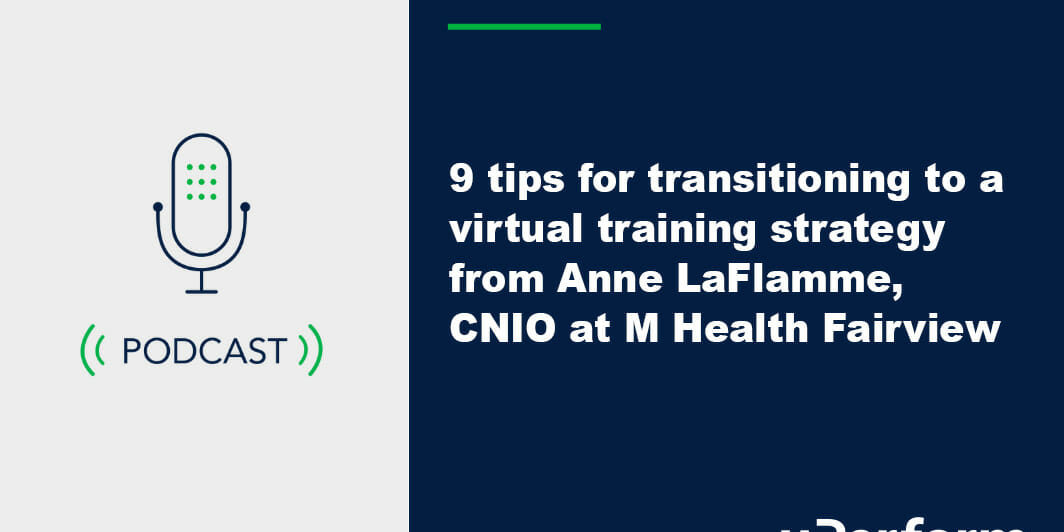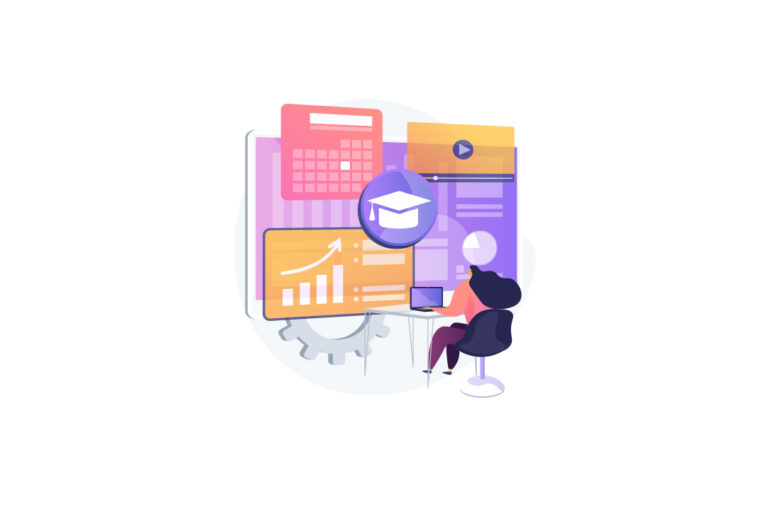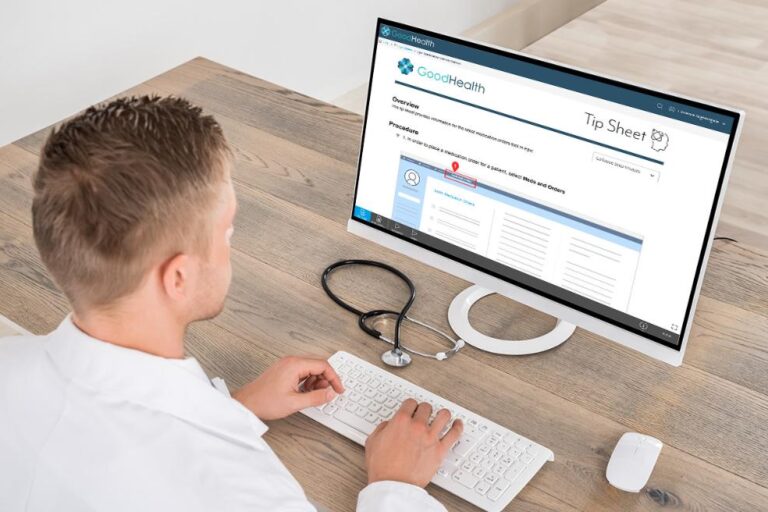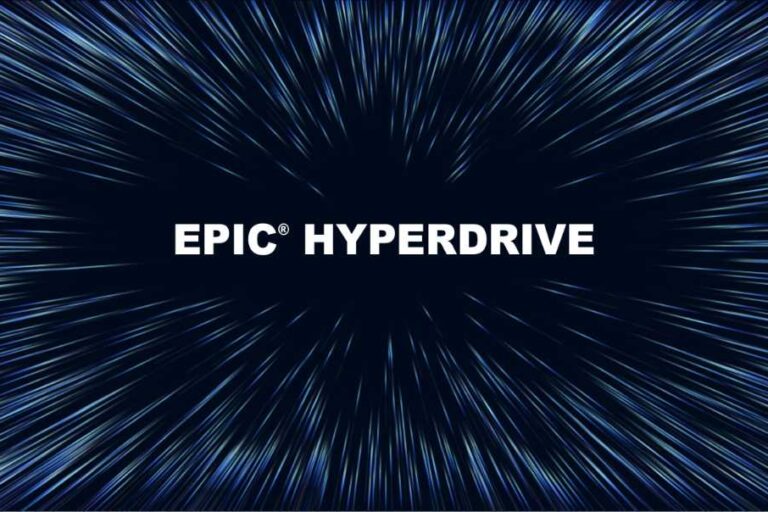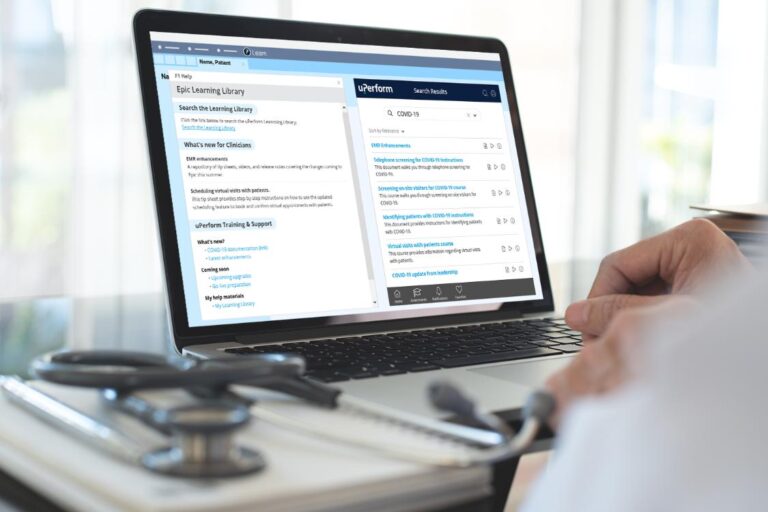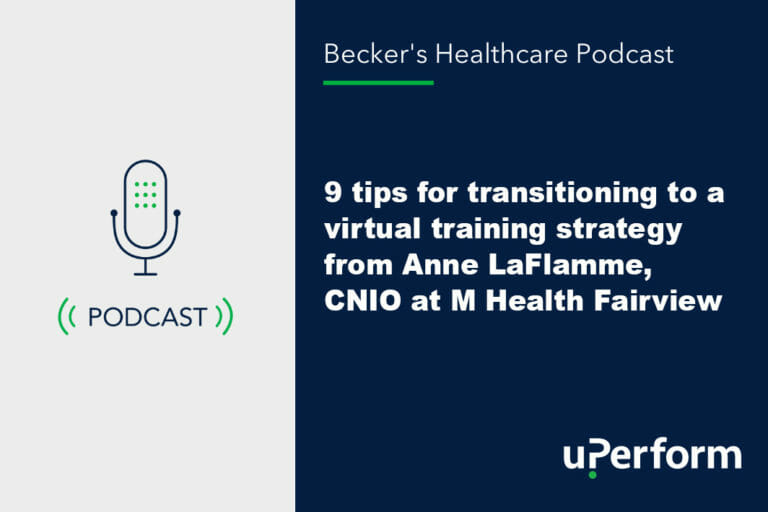Tune into our latest podcast episode with Becker’s Healthcare featuring Anne LaFlamme, CNIO at M Health Fairview, as Anne offers nine tips for successfully transitioning to a virtual Epic training strategy.
For a readable transcript of the podcast, scroll to the bottom of this page.
Anne is the Chief Clinical & Nursing Informatics Officer at M Health Fairview, a partnership between the University of Minnesota, the University of Minnesota Physicians and Fairview Health Services. Her national awards include the “Women’s Health Leadership TRUST Innovation and Technology Award” and the “School of Nursing Preceptor of the Year Award.”
As Anne and M Health Fairview were preparing for a series of acquisitions and mergers, they realized that their existing Epic training strategy was unsustainable for their anticipated growth. Knowing they needed a scalable training solution, they looked into virtual Epic training strategies. After researching available options, they chose to partner with uPerform for its ability to deliver learning content directly in the Epic EMR system workflow.
Their foresight helped prepare their training team to support staff through the pandemic, as in-person training became increasingly unfeasible. Now they are reaping the benefits of a modernized approach to EHR training that has increased end user engagement and is generating positive feedback from staff. In this Becker’s Healthcare podcast episode, Anne breaks down the factors that led to M Health Fairview’s successful transition to a virtual Epic training strategy.
1. Deliver learning in the flow of work
Anne makes it a point to credit a significant portion of her team’s success to embedding learning materials in the flow of work. When asked what are some of the best practices or lessons learned she’d like to share with other organizations still struggling to make the transition to virtual Epic training, Anne responds:
“The first thing I would say, and it’s probably the easiest thing to do if you have the right tools, is to embed microlearning at the point of work, in the flow of work, as one of the first interventions that you do in distribution of learning.”
When Anne’s team embedded a microlearning video into the eConsent navigator in Epic, they witnessed an increase in engagement with the tool from 7% to 87%.
2. Invest in your training team
Anne is careful to note that the M Health Fairview training team makes everything they do possible. Going digital doesn’t mean simply replacing trainers with digital courses.
“As we looked at the future of transitioning to digital, first we knew that we needed to really grow our own team.”
The M Health Fairview training team is responsible for course design and content creation, providing at-the-elbow support and staffing a helpline to support clinicians on an as-needed basis.
3. Rethink traditional trainer roles
For Anne and M Health Fairview, investing in the training team meant more than simply growing its numbers. Making the switch to a virtual Epic training model required them to build skills in digital and virtual learning content creation, course design and delivery.
“…moving from the trainer preparation – you know development of learning – into an actual designer role was really a critical decision that we made to move forward to a truly digital and virtual learning space.”
4. Establish a single source of truth
Centralizing learning content and providing a single source of truth for learners has been critical to M Health Fairview’s success, according to Anne.
“…understanding that we can do centralized distribution, so that we have a source of truth for all our different training and learning modules. So, we know that a nutritionist is going to see what [learning] they need based on their login, and it’s the content we have curated and that we keep up-to-date. We know it’s appropriate, current and correct.”
5. Establish a strong support network
Once an organization has the team in place to support it, Anne recommends establishing a strong support network for EHR users. While self-guided learning is a great tool for the EHR training toolkit, it’s still important to have experts that users can seek out for additional support.
“…users can reach out at any point to access an informaticist well-versed in Epic that has a whole team of people in IT and informatics behind them to help with really a broad array of questions. And we’ve seen great uptick in the use of both uPerform through the [Epic] F1 [Learning Home Dashboard], as well as accessing our support team virtually.”
6. Invest in tools that support both asynchronous and synchronous learning
Anne stresses the importance of asynchronous learning, also known as self-guided or self-paced learning. However, she also notes that even when training virtually, it’s still important to provide instructor-led synchronous training, particularly when onboarding. Finding a solution that supports both is critical to the success of a virtual Epic training strategy.
“What we focused on was where could we go to have a system that would support us in both asynchronous and synchronous learning? Asynchronous being when a user or a staff member knows that they need help with something…can actually do some self-guided learning…And then synchronous learning…where we were able to transition our classroom model to a model where we gather individuals in their spaces, whether it was a home or on the job at a workstation, and…have the instructor be the leader.”
7. Deliver learning opportunities in multiple formats
Everyone learns differently. For Anne and M Health Fairview, this meant creating and delivering content in multiple formats and making it accessible to end users.
“…wanting to provide learning in the way that the user wants to see it and wants to experience it was one of the other critical items when looking for a partner in this space. So, for instance, being able to choose how I want the information, whether it’s written like in a tip sheet format, if I want to view a quick microlearning video, or have a longer, more interactive instructional course I complete.”
8. Provide single-sign-on access to learning materials
The over reliance on software applications is one of the leading contributors of frustration and fatigue for clinicians. When choosing a platform for guiding users through their software journey, make sure to choose one that allows single sign-on access.
“With uPerform, the users is able to actually click on a button in Epic, it takes them right into the uPerform system [via Epic single sign-on], and actually knows [the] context they were logged into in Epic…and can actually cater to what they see on that initial screen to their role.”
9. Invest in the right tools, but don’t scrap your current ones just yet
There’s no one-size-fits-all approach to Epic training. Different tools offer different benefits for training teams and end users alike. When investing in new tools, take account of what tools you already have and will need to continue using before removing them from your toolkit.
“We took the time to really understand the ecosystem of our learning applications, understanding that each [tool] did still have a place in the greater scheme of things. So, we obviously still need our LMS. We still use our intranet and all our communication channels. We did find that there was a particular space and gap that uPerform helped us fill and [provided] capabilities that we didn’t previously have.”
Virtual Epic training with uPerform
uPerform is a just-in-time learning and support platform that delivers role-based learning opportunities to users in their Epic workflow. uPerform centralizes content creation, management and delivery on a single platform, easing the burden on training teams and improving the learning experience for clinicians. uPerform is also compatible with other enterprise software applications including leading ERP, HCM, CRM systems and more.
Related Articles
CASE STUDY:
Read more about M Health Fairview’s story and how it has leveraged uPerform to scale training and:
- Centralize all training and support in a single location
- Rapidly create learning materials to support an Epic double upgrade
- Significantly reduce time clinicians spend in training
BOBBY: Hello and thank you for joining another one of our Becker’s Healthcare podcast series. My name is Bobby Zarr, and I’m the Vice President of Healthcare Strategy at uPerform. Today I am joined by Anne LaFlamme who is here to discuss how M Health Fairview bridges the EHR learning gap with training in the flow of work. Anne is the Chief Clinical and Nursing Informatics Officer at M Health Fairview, a partnership between the University of Minnesota, The University of Minnesota Physicians, and Fairview Health Services. Her national awards include Women’s Health Leadership Trust Innovation and Technology Award, and the School of Nursing Preceptor of the Year Award. I will also say that Anne is a genuinely wonderful person and a terrific leader at M Health Fairview and well respected in the industry. Anne, thank you so much for joining us. Welcome, and we really appreciate you taking the time to speak with us today.
Alright, well let’s jump right in. I know you’ve got a lot to share with our listeners today.
First question and first topic is going to be: Provide us a brief overview of how M Health Fairview was delivering training and content prior to uPerform and what the catalyst was that led you seek out a shift to digital training.
ANNE: Sure. It’s interesting. We started having this conversation and the shift to digital training even pre-pandemic, which I’m grateful for. We’ll talk about that a little bit later. But we have many different partners as you can tell from the introduction and how our organization is partnered across multiple employment homes and, also, with independent clinics, independent providers. And because of all of those intricacies, we have two LMS (Learning Management Systems) and two intranet sites. Plus, just multiple different emails, email groups. And heavily relied on both emails and even print outs for staff and trying to reach our end users as broadly as possible when it came to different learning opportunities and training for our EHR and other technologies. We had pre-pandemic mostly in-person delivery of our training in a physical classroom setting. Obviously, that spanned across a really broad geography, across our system, made it hard for folks to get to that training. And it was actually expensive to support people to drive and sometimes stay in a hotel overnight to get to that physical classroom training. And then a lot of ad hoc sessions, you know, lunch and learns and, also, at-the-elbow rounding was being done. Those ad hoc sessions just weren’t organized in a way that we could say that our training was consistent or standard across different user groups. And then we had our education spread across multiple decentralized, not only systems, but also authors. So, authorship was kind of left up to whoever wanted to do it; we didn’t have a way to control our delivery mechanism centrally.
BOBBY: Speaking from experience I can tell that it’s hard enough to manage training and onboarding in a single, cohesive organization, but trying to get it across three disparate organizations as you’re trying to standardize that is really, really tough. How did uPerform help you with onboarding and initial training?
ANNE: So, we also at the same time were growing our organization, so we were merging with another health system in the area and knew with that as we continued to grow, we were needing to reach more and more individuals by our training team. So, as we looked at the future of transitioning to digital, first we knew that we needed to really grow our own team. I will say that the merge with the other health system allowed us first to centralize our training resources for our EHR, which is Epic. So that then allowed us to really provide the skills to that team and the learning to that team to become proficient in digital and visual learning creation and, also, delivery. So, both of those – really moving from the trainer preparation, you know development of learning into an actual instructional designer role was really a critical decision that we made to move forward to a truly digital and virtual learning space. We also with that, we did have limitations on our staffing model on our team and needed to be able to efficiently release and distribute our learning across larger and larger groups of new employees onboarding into our system. So that became really critical just from a basic team structure position for me to make sure that we made that leap. Then in addition we really, naturally needed a system and an application that would help us to do all of those things efficiently and hopefully seamlessly. So, what we focused on was where could we go to have a system that would support us in both asynchronous and synchronous learning? So asynchronous being when a user or a staff member knows that they need help with something but doesn’t know where to go, somewhere they do know where to go and can actually do some self-guided learning. Find what they need at the time that they need it, anytime, doesn’t matter day or night, and be able to find what they need to answer their questions in the moment and lead themselves through that. And then synchronous learning, specifically virtually, where we were able to transition our classroom model to a model where we gather individuals in their spaces, whether it was a home or on the job at a workstation, and could gather individuals virtually into a class and then have the instructor be the leader, again virtually in that training session, and lead all of those individuals who are in different places through the same course, through the same content, in a way that was very interactive. So, we were able to accomplish both of those. And then also really wanting to provide learning in the way that the user wants to see it and wants to experience it was one of the other critical items when looking for a partner in this space. So, for instance, being able to choose how I want the information, whether it’s written like in a tip sheet format, if I want to view a quick microlearning video, or have a longer, more interactive instructional course I complete. So those kind of three things were what we were looking for in a partner.
BOBBY: Now that you’ve taken training beyond that virtual initial onboarding…Seeing that learning in healthcare is just a never-ending journey, what else are you doing to deliver training in new ways?
ANNE: Yeah, so what we’re so excited about uPerform is it met all of what I just talked about, which was the asynchronous, synchronous virtual learning, and also really focusing on how we deliver learning in the flow of work. So, what that means is that it is available and accessible at the point-of-care when and where the user needs it. So, a couple of things that we were able to accomplish with uPerform and that were really important to us, was that we can access uPerform and the content that we house there using a single-sign-on approach, so that we didn’t have to have individuals going from Epic out into another window to open an application, login again, and then search for their appropriate learning materials. With uPerform, the user is able to actually click on a button in Epic, it takes them right into the uPerform system, and actually knows their context they were logged into in Epic – whether it’s a nurse, a provider, a respiratory therapist, a nursing assistant, an ambulatory provider, an MA, etc. – and can actually cater to what they see on that initial screen to their role. So they are actually getting to the learning that is pertinent to their role right away without even having to initiate a search. They have the building blocks right there. Even when the user does search, it is a great search engine. People are able to find what they need almost immediately. I go in there all the time, and it is rare that within the first three items that appear based on my search that I am not getting the right content that I’m looking for. So just a really excellent search engine. And also understanding that we can do, now, centralized distribution, so that we have a source of truth for all of our different training and learning modules. So we know that a nutritionist is going to see what they need based on their login, and it’s the content that we have curated and that we keep up-to-date. We know it’s appropriate, and current, and correct. So that gives us a lot of confidence in what we’re delivering to our team as they need information for what they’re doing on the job. One instance where we found the centralization of our learning distribution really critically important to our operations was during the pandemic when we were bringing in new nurses, whether employed or traveling nurses, and needed to expedite their onboarding really quickly to get them to the bedside to take care of our increasing patient acuity and increasing numbers of COVID and other patients in our hospitals. With that we were able to design and author a module specifically for those nurses with a comprehensive outline of Epic for their area of expertise. And they could work through that to get the information that they needed based on the patient population that they were first coming onboard to take care of during the pandemic, and we’ll continue to use that as we need to onboard nursing for different, hopefully not frequent, emergencies or pandemics like we just had, but as we need to.
BOBBY: I love that. Having that one single source of truth with a Google-like search that is relevant to your role is so important out there. That really does take what you guys are doing beyond training, which I’ve always said ‘training’ is the process; ‘learning’ is really the outcome you’re trying to achieve. And learning really happens where the user works and when the user needs to learn something. So it’s really powerful to be able to deliver that single source of truth at the moment of need for the user. Even with learning being an outcome and in healthcare we’re all about outcomes, aren’t we? Talking about outcomes, can you give me an example of some measurable benefits you’ve seen from a revamped training strategy?
ANNE: Yes, we’ve had two examples recently in the last 6-8 months. So we rolled out our econsent workflows using Epic in our preoperative and surgical departments. And with that, we actually began with our first way that we experimented with the microlearning videos – directly in the flow of work. Specifically what that means is, if you have a surgeon or a nurse who is getting ready to review and sign the pre-procedural consent with a patient at the bedside the day of their surgery, we actually embedded a quick 30-second video within the navigator in Epic right where you do the econsent. They were able to say if they were new or needed a refresher. Also it was really great that the nurses were showing the surgeons that it was there. And it just took on a life of its own. People use that. And we saw in our data that before we embedded that microlearning video into the navigator – the econsent navigator – we had about a 7% use of the tool out in the wild – out in the real world. And after we embedded that microlearning video, we saw 87% use of the econsent tool. And this was during the go-live, but we really believe that microlearning was a huge help and helped us with the consistent use of the new technology for patient consent.
And then the other was we just implemented new content for documentation in our emergency departments. And we did this as kind of a big go-live across 11 emergency departments in the system. This was for all of our ED nurses, our techs, [charge nurses?], assistants, etc. that worked in the ED. We really were changing and upending the way that they completed from their triage – their patient triage – to how they documented their education – getting the patient out the door home or transitioning them into the inpatient unit for their next level of care. So we had about a 10% read rate before we used uPerform to deliver the ED education, and that was consistent across the system for different go-lives that we had done previously. We rarely saw a read rate of our materials ahead of a go-live or change that was above 10% at any of our locations across the system. Using uPerform to deliver this emergency department clinical documentation training for every ED that we had across those 11, the lowest completion rate – or read rate – that we had was 57%. The highest was at 88%. And that was just phenomenal. And we thought during that go-live it was so smooth. And we really credit- as prepared as we can have the end user be for any type of change and give them the learning materials that they need to be as aware of and as prepared for the change as possible but then also know where to go if they don’t know or can’t remember something, that we have a really smooth and successful go-live. And that is definitely what we saw here, and uPerform played a big part in that.
BOBBY: I’m going to steal your world yourself – phenomenal. Thank you for those great examples of measurable benefits that you’ve seen. They truly are phenomenal results out there. With that success that you’ve had and what you’re seeing for the future, healthcare is one of the great industries that shares those best practices and successful outcomes across the board. I think learning should be no different out there. What are some of the best practices or lessons learned that you’d like to share with other organizations still struggling to make the transition to virtual learning?
ANNE: The first thing I would say, and it’s probably the easiest thing to do if you have the right tools, is to embed microlearning at the point of work, in the flow of work, as one of the first interventions that you do in distribution of learning. We waited, mainly because it was new, and we knew that we had to get through transition of other content before we started producing and embedding the microlearnings. It has such a – not just the great impact it had on the different tools that we were implementing – but also the word-of-mouth and kind of the ‘cool’ factor from the staff saying like ‘This is great. I love that this is right here, right in Epic. When I click on it, the window actually doesn’t overtake my screen. It’s a pop-up window, so I can easily know I’m still in my system. I can go right back there after I’ve seen the video, close it out, and I’m good.’ So it’s really slick and just a great way to make it really easy and digestible in the moment for staff to be able to know how to do the right thing when we need to give them that little bit of information to be able to do so. Also, we found that using QR codes became a really great way to visually communicate to people outside of email. So if we did posters with QR codes that link directly to the content. So if I’m on my cell phone, I put that QR code in and it takes me right to the web version of uPerform, and I’m able to get to that direct content that I linked to, so directly related to a specific learning maybe for a specific go-live on a specific unit. You can get really down to that level. So really getting the user to the right content at the right time. And it is available on desktop, tablet, and mobile, so that makes it really easy for people to take it with them. And also in the spur of the moment, to get something done. Which we know is how a lot of healthcare workers and frontline staff are able to do their work. It’s a constant flow. You’re constantly prioritizing and reprioritizing, so having that easily available is really important.
And then, overall, we took the time to really understand the ecosystem of our learning applications and understanding that each of those did still have a place in the greater scheme of things. So, we obviously still need our LMS. We still use our intranet and all of our communication channels. We did find that there was a particular space and gap that uPerform helped us fill and also the capabilities that we didn’t previously have. When it comes to the frontline groups really adjusting to system changes and support post-implementation as well that uPerform became a tool that helped us to make that change successful from the point of learning to the point of post-implementation and maintenance of a change.
BOBBY: That’s great. I think ‘change’ is the operative there. If there’s one constant in healthcare that we all face on a day-to-day basis, it’s ‘change.’ And as a successful leader, your job is to anticipate and help manage that change. So along that line, change is going to be coming. We all know it. We see it. What do you see for the future of uPerform and learning at Fairview?
ANNE: We’ve taken our digital and virtual push to kind of the next level and applied it to our support model. We use a couple of things. One is continuing the integration with Epic. We’ve used our F1 button – so the F1 button in Epic, you can actually pop up an informational window. Once a user presses F1, and they’re in Epic, you get the informational window that gives the user the link directly to uPerform to get to the content that is, again based on their role and their login context in Epic. It also links them out to a Microsoft Teams chat, so it’s a consistent chat link, and we’re able to actually have a support team that really staffs that chat. Then users can reach out at any point to access an informaticist well-versed in Epic that has a whole team of people in IT and informatics behind them to help with really a broad array of questions. And we’ve seen great uptick in the use of both uPerform through the F1, as well as accessing our support team virtually. And this was extremely helpful obviously during the pandemic when we pulled our site support groups back from actually rounding on site. Glad to say we’re getting back to that now, which has been great, and the feedback we’ve received from staff that have used that Teams chat and uPerform has been exceptional. They’re really happy with that transition and how it’s worked out. They’ve gotten good service from both tools. Also we’re very excited. We are in the process of creating leader dashboards that give leaders the ability to actually see their staff’s – so their staff in their department – utilization of uPerform by the staff. So you have that single view of the learner and where they are in the expected learning process. So we’re excited to roll that out later this year.
BOBBY: That’s great. I’ve heard from some of your users that it’s like having an old friend out there with them on the front lines. That they’re no longer alone. They’ve got help when and where they need it, which is a good feeling. You guys have had a long journey through COVID and getting here, as well as the consolidations of two instances of Epic. The challenges of combining health systems. I’m proud to have you guys as a customer and a friend and a partner in this journey. I do appreciate your time today, Anne. And we’ve just enjoyed our chat today.
ANNE: Likewise. We have been so happy to partner with uPerform. I think I can say both of our teams have really knocked it out of the park, and it shows. So thank you very much for having me; I’m so excited to share our story.
